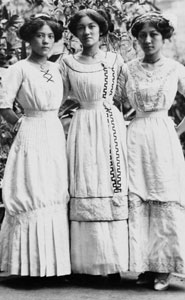Between 1842 and 1954 tens of thousands of Britons visited or lived in China, and many bought, commissioned, or took photographs while they were there. Discovered hidden away in attics and cupboards, these photographs provide a record of a colonial life-style now long gone, and a China that is rapidly vanishing. Such images are of immense interest.
The Historical Photographs of China Project, led by Professor Robert Bickers in the Department of Historical Studies, aims to track down such photographs held outside China that are either in private hands, or are locked away in libraries and archives which do not have the capacity to make them available. So far, over 8,000 photographs have been digitised and are available for educational, reference and research purposes.
They offer insights into working and social life, architecture, commercial history. dress and fashion
The photographs come from the collections of a Chinese diplomat, foreign businessmen, staff of the administrations in the Chinese treaty ports, missionaries, and officials of the Chinese Maritime Customs Service. They shed light on political events such as the May Thirtieth Incident in 1925, in which a nationwide series of strikes and demonstrations was precipitated by the killing of 13 labour demonstrators by British police in Shanghai. They also offer insights into working and social life, architecture, commercial history, dress and fashion, industrialisation, crime and punishment, foreigners in China and the Chinese abroad, and of course the history of photography in China. They were taken by talented amateur photographers, foreigners ‘snapping’ their trip, professional studio photographers and many others.
In the spring and summer of 2008 an exhibition of the images will be shown at the Museum of East Asian Art in Bath, and the Oriental Museum at Durham University. A book Picturing China 1870 - 1950 accompanies the exhibition. Funding for the project was provided by the Arts and Humanities Research Council, John Swire and Sons, and the University’s Centre for East Asian Studies. The team’s work has recently been awarded Academy Research Project status by the British Academy. The Academy awards this status to the ‘very best academic research’ of this type.
Click here to view the digitised collection

